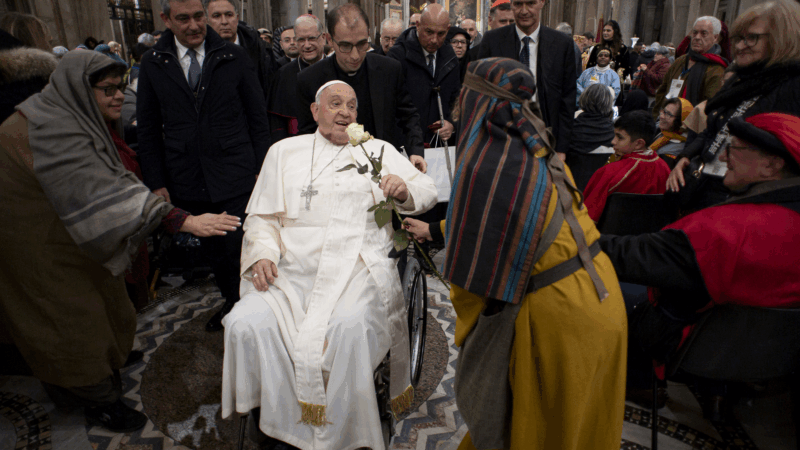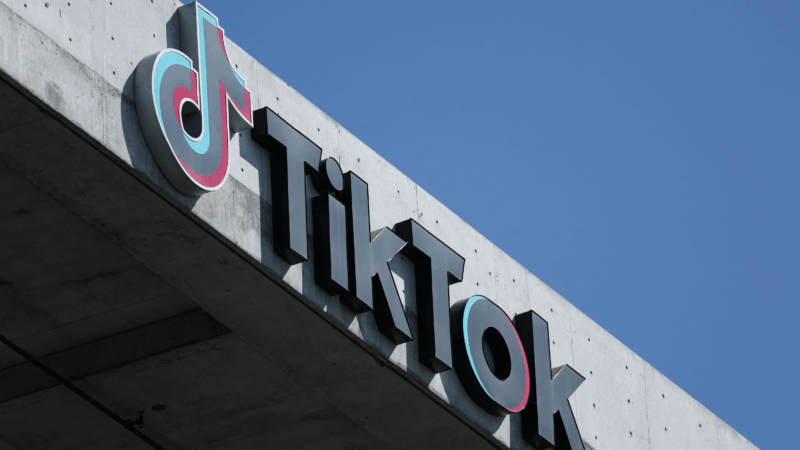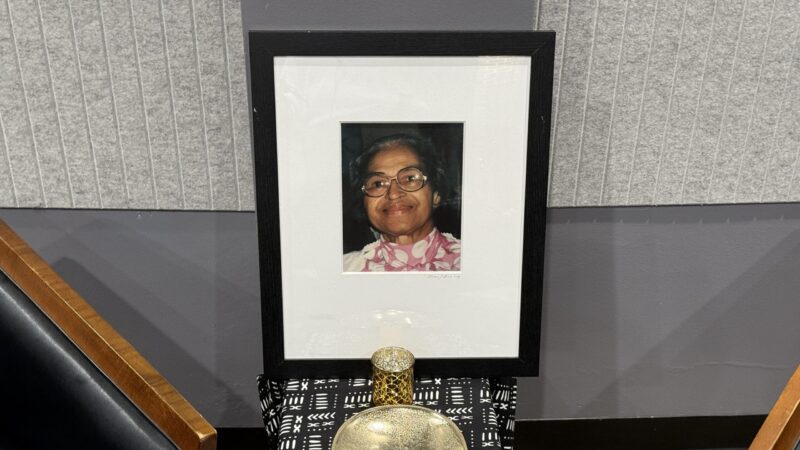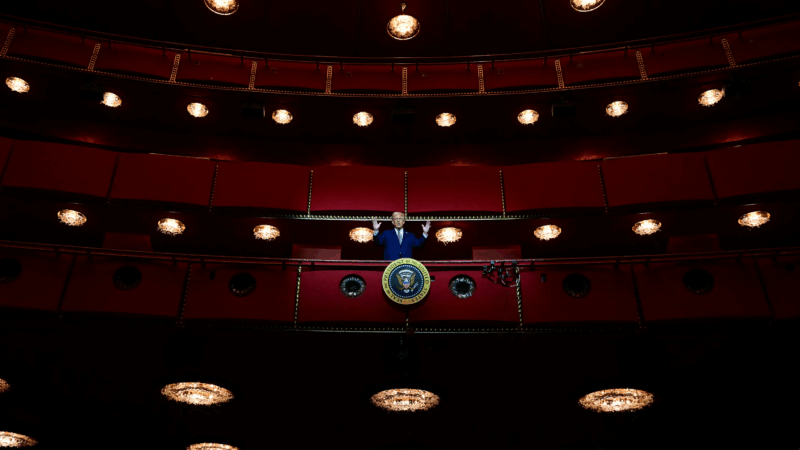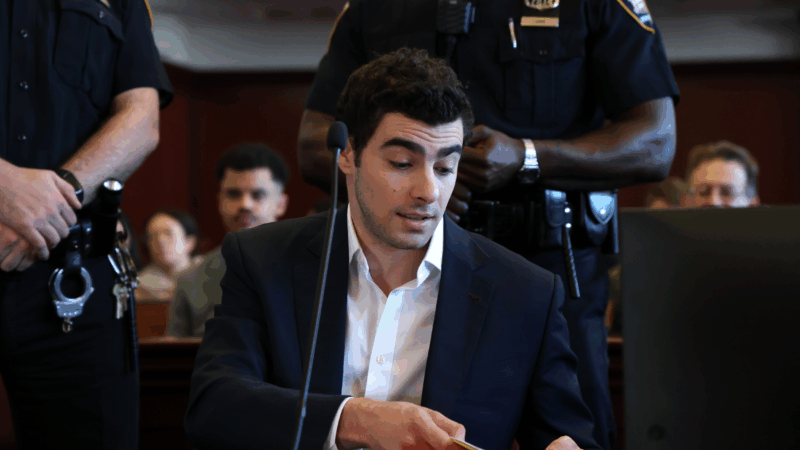What it’s like in the church Pope Francis chose as his final resting place
ROME — Pope Francis will be the first pontiff in more than a century to be buried outside the Vatican Grottoes. After his funeral on Saturday, he will be laid to rest in the Basilica of St. Mary Major, which stands sentinel across the city in the Esquilino district.
The decision by Pope Francis to do this, Cardinal Rolandas Makrickas told NPR, was the result of “divine intervention.”
Legend has it that this fourth century church was built after the Virgin Mary appeared in a dream to an aristocrat, Giovanni, and to Pope Liberius, requesting a house of worship in her honor.
Pope Francis told Mackrikas, who is the coadjutor archpriest of the Basilica of St. Mary Major, that the Virgin Mary appeared before him, requesting that he be laid to rest in her church.
“The intervention was, I would say, divine from Mary directly,” Makrickas said. Francis recounted the story of the Virgin Mary’s appearance before him during a meeting at his residence in which the Pope asked Makrickas to make the necessary arrangements for his tomb at the basilica. “He told me: ‘I am very I am so happy that Mary didn’t forget me.’ “
Throughout his papacy, Pope Francis visited St. Mary Major basilica — with its colonnades of cipollino marble and intricate statues — 126 times. He went there principally to pray to the Salus Populi Romani, health or protectress of the Roman people in Latin, a painting on cedar wood that shows the Virgin Mary holding baby Jesus. This icon was brought to Rome from the East in the fifth century, when Mary was declared the Mother of God at the Council of Ephesus in 431. Tradition holds that it was painted by St. Luke the Evangelist, whose written narratives became the gospel that bears his name and the book of Acts in the New Testament.
The Virgin Mary icon seemed to become almost an ally for Francis in his papacy. He visited her on his first day as pope in 2013, and would pray to her before and after every trip out of Rome. It was the first place he went after he was discharged from Gemelli hospital in March to convalesce from double pneumonia at the Vatican. And he returned to pray there just days before he died on Easter Monday.

The Salus Populi Romani is said to have saved Rome from a plague in the year 590, when Pope Gregory the Great organized a procession with her through the city streets.

And during the coronavirus pandemic in 2020, Pope Francis had her brought to St. Peter’s Basilica, where he prayed in the rain, standing almost alone in an empty St. Peter’s Square.
“We know that you can take care of us,” Francis said during his prayers.
Seven other popes are buried at St. Mary Major. “But the vast majority of these popes were buried here during the 120 plus years it took to build St. Peter’s Basilica,” says Agnes Crawford, a longtime guide in Rome. “So for a sort of logistical reason, rather than necessary preference.”
In the days leading up to Francis’ funeral, the basilica has been alive with visitors curious to see the church where he will be buried. The chapel that houses the Salus Populi Romani was crowded with faithful in prayer. Their words and song rang out into the high ceilinged basilica.
And beside the chapel was the nave where Francis will be buried. At the time NPR visited this week, it was obscured by chipboard panels as works continued on Francis’ burial vault. The Vatican later released a photo showing the tomb ready to receive him after the funeral. On the back wall of the nave hangs a replica of Francis’ pectoral cross. And on the ground is a simple marble stone containing a single word engraved: Franciscus.
The simplicity of his resting place follows the express request made by Francis in his will. Pope Francis shunned much of the pomp and frills of papacy — choosing simpler dress, eschewing chauffeurs or, if he did have to be driven, appearing in a modest Fiat car (when not riding in the popemobile).
Popes are traditionally buried inside three nested coffins: one of cypress wood, one of elm and one of lead. Francis has chosen a single wooden casket lined with zinc.
“The message we took from Francis’ simplicity is that he was trying to make people understand that we are all the same,” says Giuseppe Cipolla, who had come to visit St. Mary Major with his wife and two children. “And that this planet is for everyone — there shouldn’t be the privileged and the poor.”
Francis will be the first pope in more than 350 years to be buried at the Basilica of St. Mary Major. (The last one was Clement IX.)
For 16 centuries, this basilica has stood sentinel. Today, the Esquilino district where it is housed has a large immigrant population and the city’s main train station. Historically however, the area — the Esquiline Hill — was one of the seven ancient hills on which Rome was founded.
The foundational story is a miraculous tale. After the Virgin Mary appeared to the aristocrat Giovanni, and to Pope Liberius in a dream asking for a church in her honor, she told them they should build it in a location that would be miraculously revealed. Then, it snowed on this hill in Rome, on Aug. 5 — the height of summer.
Transcript:
ARI SHAPIRO, HOST:
After his funeral on Saturday, Pope Francis will not be buried in the frescoed grottoes of the Vatican, the traditional papal resting ground. Instead, he chose St. Mary Major, a basilica on the other side of Rome. It’s the first time in more than a century that a pope will be buried outside the Vatican walls. Throughout his papacy, Francis went there to pray to an icon of the Virgin Mary holding baby Jesus. In death, he’ll lie in a simple tomb beside her chapel. NPR’s Ruth Sherlock takes us there.
(SOUNDBITE OF ORGAN PLAYING)
RUTH SHERLOCK, BYLINE: This Church of St. Mary Major is alive with visitors. Every room, every chapel is filled with people coming to see the place where Pope Francis will be buried.
(SOUNDBITE OF ORGAN PLAYING)
SHERLOCK: For 16 centuries, Agnes Crawford, a longtime tour guide, tells me this basilica, with its colonnades of Cipollino marble and intricate statues, has stood sentinel.
AGNES CRAWFORD: We’re really on the summit of the Esquiline Hill, which is one of the seven of the ancient hills on which Rome was founded.
SHERLOCK: The church has special resonance for Pope Francis, who visited before and after every trip out of Rome. It was first built in the 4th century.
CRAWFORD: Following a rather wonderful, miraculous tale, which involves a snowfall on the 5 of August.
SHERLOCK: The story goes that the Virgin Mary appeared to an aristocrat, Giovanni, and to Pope Liberius in a dream, asking for a church in her honor, in a location that would be miraculously revealed. And then it snowed, just on this hill in Rome, in the height of summer.
And that was seen as a kind of sign that a church should be built on this hill?
CRAWFORD: It was seen as an indication of the place where the church should be built.
SHERLOCK: And in this century, it still has great importance.
CRAWFORD: It houses the icon which was especially dear to Pope Francis.
SHERLOCK: The icon, called the Salus Populi Romani – health of the Roman people in Latin – is a painting on cedar wood that shows the Virgin Mary holding baby Jesus. Tradition holds it was made by St. Luke the Evangelist, whose written narratives became large parts of the New Testament. We go to look.
Here we are in front of the icon of Mother Mary in the St. Mary Major church. People are gathered in this side chapel.
UNIDENTIFIED PERSON: Sorry (ph).
SHERLOCK: (Whispering) Oh.
UNIDENTIFIED CHOIR: (Singing in non-English language).
SHERLOCK: Beside the chapel where people are praying is the nave where Pope Francis will be buried. When we visited, the area was shielded by chipboard panels. The Vatican later released a photo showing a simple marble tomb on the ground with one word engraved – Franciscus.
UNIDENTIFIED CHOIR: (Singing in non-English language).
SHERLOCK: This icon is said to have saved Rome from a plague in the year 590, when Pope Gregory the Great organized a procession with her through the city streets. So it took on special resonance during the coronavirus pandemic in 2020, when Pope Francis had the icon brought to him to the Vatican. He prayed with her beside him for an end to the modern-day plague, standing in an empty, rain-soaked St. Peter’s Square.
(SOUNDBITE OF ARCHIVED RECORDING)
POPE POPE FRANCIS: (Speaking Italian).
SHERLOCK: The Virgin Mary icon seemed to become an ally for Francis in his papacy. On his first day as pope in 2013, he slipped out of the Vatican to visit the shrine, and he returned to St. Mary Major church 126 times. It was the first place he went after he was discharged from Gemelli Hospital in March, and he returned to pray there just days before he died on Easter Monday. Cardinal Rolando (ph) Makrickas, archpriest of the basilica, told NPR that Francis often spoke of his devotion.
ROLANDAS MAKRICKAS: He was telling that, I want that Mary looks at my life – at me – and I want her protection and her help.
SHERLOCK: Francis will be the first pope in centuries to be buried at St. Mary Major. Cardinal Makrickas explains why.
MAKRICKAS: The intervention was, I would say, divine – from Mary directly. It was very special, his experience.
SHERLOCK: Just as legend says the Virgin Mary appeared to Pope Liberius in the 4th century asking him for this church, so Francis told Makrickas she appeared to him one day, asking him to be buried at the St. Mary Major.
MAKRICKAS: He told, I am very – I am so happy that Mary didn’t forget me.
(SOUNDBITE OF BELLS TOLLING)
SHERLOCK: And so, after his funeral on Saturday, Pope Francis will be laid to rest beside her. Ruth Sherlock, NPR News, Rome.
(SOUNDBITE OF BELLS TOLLING)
Suspect in Brown University shooting found dead in New Hampshire
The suspect in the shooting at Brown University Saturday was discovered dead Thursday at a storage facility in New Hampshire.
TikTok signs deal to give U.S. operations to Oracle-led investor group
The agreement aims to resolve a yearslong standoff between the popular social media platform and the U.S. government over national security concerns tied to China's parent company, ByteDance.
A family reunion to commemorate the Montgomery Bus Boycott
This month marked the 70th anniversary of the historic Montgomery Bus Boycott. The demonstration was catalyzed when Rosa Parks refused to give up her seat on a bus. The boycott lasted over a year and is considered a spark of the Civil Rights Movement.
President Trump to add his own name to the Kennedy Center
The arts institution will be called the Trump-Kennedy Center. The president's press secretary said it comes after a unanimous vote by the center's board, which Trump took over earlier this year.
Mangione pre-trial hearing wraps, but judge won’t rule on evidence for months
After three weeks of testimony, a judge will now rule on whether evidence found in Mangione's backpack can be used in his state trial for the murder of UnitedHealthcare CEO Brian Thompson.
Lucy Liu on ‘Rosemead,’ rejection and returning to Mandarin
The child of Chinese immigrants, Liu didn't learn English until she was 5. She plays a terminally ill woman grappling with her teenage son's mental health crisis in Rosemead.

